ALL...ABOARD!: Stevens Rail Trail
Introduction
Text-to-speech Audio
Images
A view of the Stevens Rail Trail.
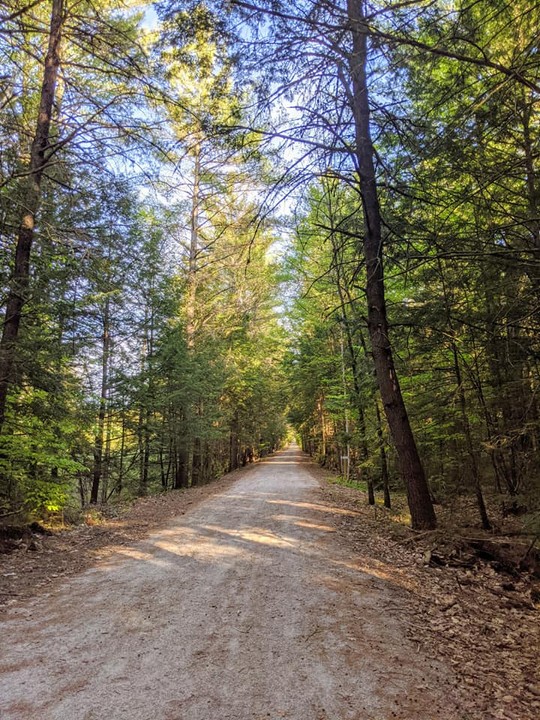
Map of the Stevens Rail Trail.
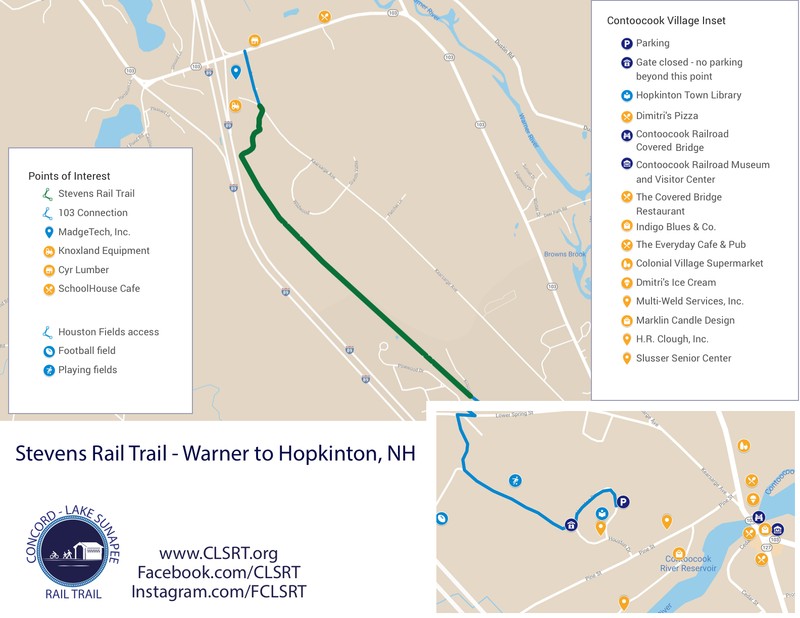
Mile post marker C.J. 44.

Rail rests near mile post marker C.J. 44.

Lady's slippers.
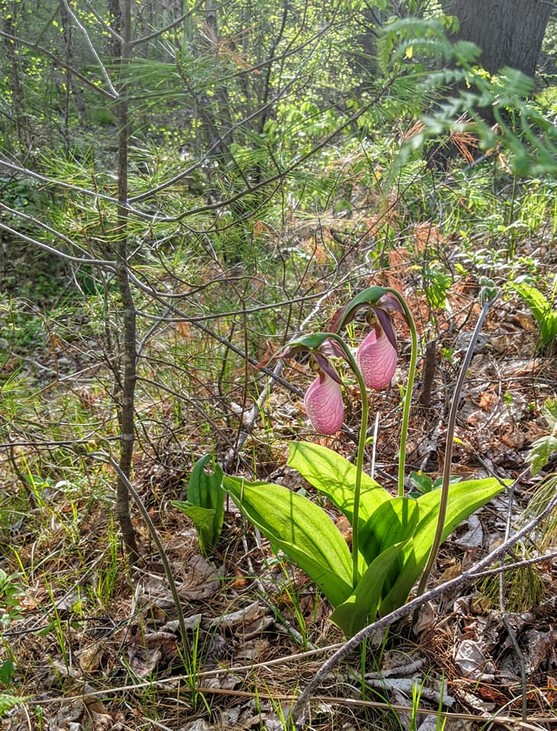
Rock near the power lines with numbers on it.
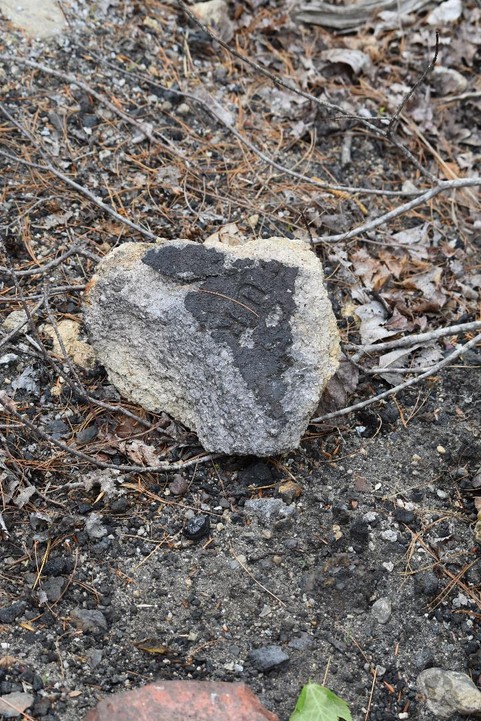
Rocks near the power lines with letter and numbers on them.
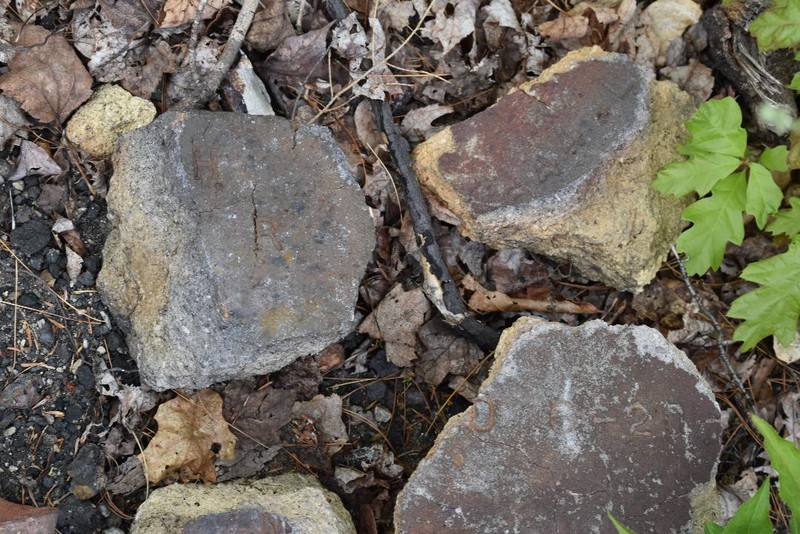
Newbury Cut
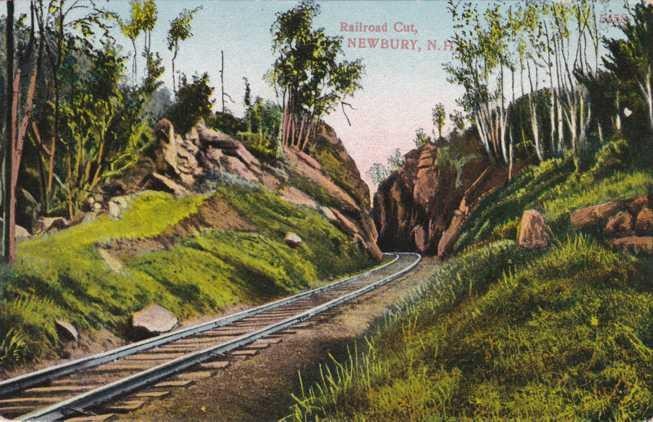
Backstory and Context
Text-to-speech Audio
Directions: Park at Houston Fields behind the Library (61 Houston Drive). After parking, follow the gravel road next to the playground towards the back athletic fields. Just after reaching the field, turn right on another gravel path and follow it through the woods to Spring Street. The trail starts on the north side of Spring Street at the beginning of Krzyzaniak Lane.
As you walk or ride along the Stevens Rail Trail, there are a number of interesting things to see. One is the mile post marker CJ 44, indicating the Claremont Junction is 44 miles away. Nearby this mile post marker is a rail rest, which was used to store spare rails in case repairs were needed. Just beyond the power lines which cross over the trail are several rocks. If you look closely, you can see letters and numbers. We're not sure if these rocks were part of the railroad. If you have any information or guesses about them, we'd love to hear from you. Finally, if you happen to be on the trail in late spring, you will find an abundance of lady's slippers blooming.
The Railroad from Contoocook to Claremont
The first train arrived in Contoocook from Concord in 1849 amid great fanfare; however, it would take more than 20 years for trains to Claremont. Trains did not reach Bradford until July 1950. And not until the Newbury Cut was completed in 1871 were trains able to travel to Newport and finally, in 1872, to reach the Connecticut River at the Claremont railroad tracks.
From the Newbury Historical Society Winter 2011 newsletter:
CONQUERING THE NEWBURY CUT
The mid-1800s was a time of railroad fever in New Hampshire. Train transportation was recognized as a flagship of progress, opening lines of communication and commercial opportunity between the metropolitan areas of New York, Boston, and up through central New Hampshire to Canada. As railroads linked major communities and business expanded, the builders and investors reaped high rewards. By the 1840s, lines reaching west and east of the Merrimack River were being chartered, including the Concord & Claremont (C&C) Railroad in 1848.
While many of the short lines fell victim to financial problems and political wrangling, the C&C was financed largely by subscriptions from local investors and managed to survive. By the summer of 1850, the C&C owned two locomotives, 60-odd freight cars, three passenger and two baggage cars. The Claremont, a 23-ton, 4-4-0 engine, ran between Concord and Bradford. Profits came not only from passengers but more importantly the ever-expanding freight which included lumber, bobbins, powder kegs, woolen textiles, harness hames, scythe stones, livestock, and, later, milk and ice. Postal cars were added to carry mail. The railroad brought prosperity to Bradford but the line stopped there. Travelers wanting to go to Newbury or points west had to resort to stage.
The problem facing C&C's intent to carry the line to Claremont was the formidable Newbury summit, a granite barrier climbing at a grade of 100 feet per mile. The story of creating the Newbury Cut is a well-known chapter in local history, but the delay in completing the line to Claremont involved more than conquering a physical obstacle. In the ensuing 20 years, the C&C, like many other branch lines, fell victim to a depressed economy and scrambles for money and political power. The controlling Northern Railroad employed "hostile takeover" powers to check its smaller competing lines. Scandals reaching as far as the governor's office abounded, but as anti-railroad sentiment built, so did the determination of several individuals to complete the C&C line to Claremont.
Dexter Richards of Newport, owner of the Sugar River Mills, contributed $20,000 of his own money on top of Newport's investment of $45,000 to extend the line. Other towns along the route pledged financial support to meet the construction costs of $20,000 per mile. Despite lack of full funding, the Sugar River Railroad extension was activated in May of 1870 in Newport. The Newport Argus described the ground-breaking ceremony:
"Seth Richards [father of Dexter] was fitly chosen to seize the shovel and break the first sod. He went to work with all the energy of a much younger man and made the dirt fly merrily... the barrow was filled in less than 25 minutes. About this time, the cannon began to speak and our church bells began to furnish music for [the] occasion which was continued until the work ceased."
During the summer preparations were made to attack the Newbury summit. In August, blasting contractor August Floyd, using a steam drill and tenpound charges of Black powder, began blasting away at the 10,000 cubic feet of granite. A 2 1/2 inch bit drove forward at a rate of nine feet in 50 minutes, shaping holes for the explosive powder. Work went on until February of 1871, when the contractor went bankrupt. The Railroad Corporation stepped in and work continued under the management of Moses Gould, an early railroad conductor and, before that, a stage driver. During the summer of 1871 a crew of 50 men worked 'round the clock, seven days a week. The project was a great local attraction and drew a steady stream of onlookers. Entire families would make an outing to the site after Sunday services. Such kibitzing was not without its hazards. In May, the Argus reported that a Mr. Bard was "injured by a blast with a battery at Newbury Ledge." In July, Mr. A. Smith fell from a stone-filled dump car and "miraculously escaped the wheels of the cars, having received but a few slight bruises." The next day, Joseph Harvey, described as "an elderly gentleman," was asked to move back when the blasting horn sounded a warning. He refused to retire more than a few feet, and "a shower of stone fell about him and ... hit him in the thigh. He fainted away from the shock, but his injuries were not serious."
In August, a more serious incident involved three workmen who were "blown up" by a blast half a mile below the summit. According to the Concord Monitor, "they had made a blast and opened a seam into which they were turning about half a keg of powder...when the latter exploded. Dr. Fitch ... represents them as being very seriously burned, although hopes are being entertained for their recovery." In another incident, a flat car loaded with iron rails broke away and began rolling downhill toward Bradford -- three miles away. Just before the station it collided with a gravel train, wrecking some cars and damaging the rest. Two people were killed and several injured.
The work continued; the Cut was widened and framework and tie was laid along the line in either direction from the summit. In late summer, the Concord Monitor reported, "a big blast was made at Newbury Summit...breaking up more rock than any previous blast...The very foundation of the Summit was shaken."
On September 11, 1871 the summit was conquered. Reporters, railroad men and state and local dignitaries turned out to celebrate. The Concord Monitor reported on a party traveling from Concord to Bradford, with the Cut as their destination:
After an excellent dinner at the Presby House, [we] started at two o'clock for the summit, it being the first passenger train which ever passed over the road. The engine was driven by George Wright with Hiram Gillingham for Brakeman." The train stopped near the Cut as the final explosive was fired, shattering the last of the granite. The party "returned to Bradford for tea...highly delighted with their excursion over so pleasant a road."
A passenger train went into immediate service between Bradford and Lake Sunapee, although it would be another year before the 58-mile C&C line was completed in Claremont, connecting with the Sullivan Railroad.
The completion of the C&C line ushered in an era of vitality and prosperity to the towns it served. For Newbury and Sunapee it was the beginning of a thriving summer trade in tourists and visitors, met at the train stations by steamboats ready to ferry them to their boarding house or grand lake-side hotel. It was an idyllic time, key to promoting the character and growth of Newbury. But other, less happy realities were at play. The Newbury Cut remained a trouble spot for the C&C, especially in winter. While Concord was 228 feet above sea level, the summit at Lake Sunapee was 1,126 feet. A moderate snow storm in Concord usually meant a white-out at Newbury Cut. Despite the efforts of wooden snowplows on the lead locomotives and crews shoveling the drifts, snow in the Cut could be a serious impediment. Brutal snowstorms that filled the Cut to the brim, requiring neighbors' teams and sleds to haul away the snow, became local legend.
On a Friday evening in February, 1873, it was snowing heavily in Concord when the snowplow car led out three eight-wheeled engines, followed by baggage cars and coaches carrying weekend travelers. When they reached Bradford three hours later, Conductor Perry urged the passengers to disembark, and all but 18 men did so. The train continued, climbing slowly through drifts that reached six feet, then ten. When the train stalled, the crew jumped out to shovel, but very little progress could be made. There was no food on board, and with a dwindling supply of wood and dropping temperatures, Conductor Perry deemed it the "rashest folly" to attempt to go on. The engines were kept hot during the night to keep the water pumps going. As the snow let up toward morning, the crew backed the train downhill to Bradford, shoveling as they went.
In the end, it was not storms or accidents that brought down the C&C Railroad. Far more serious were the financial problems that resulted in ongoing mergers. The C&C was swallowed up by the Boston & Maine. Equipment, rails and bridges suffered from neglect, and while there was a brief resurgence of service and maintenance during World War II, the end of an era was at hand.
Excerpted from SooNipi Magazine, July 1997, article by Shelly Candidus
Sources
Concord – Lake Sunapee Rail Trail. Accessed May 22nd 2020. https://concordlakesunapeerailtrail.com/.
Conquering the Newbury Cut. Newbury Historical Society Newsletter. Winter 2011. 1 - 3.
Mead, Edgar T.. Through Covered Bridges to Concord. Brattleboro, VT. Stephen Greene Press, 1970.
Heather Mitchell
Friends of the Concord-Lake Sunapee Rail Trail
Heather Mitchell
Heather Mitchell
Heather Mitchell
Elissa Barr
Elissa Barr
https://www.hippostcard.com/listing/the-railroad-cut-at-newbury-nh-new-hampshire-db/1902716
